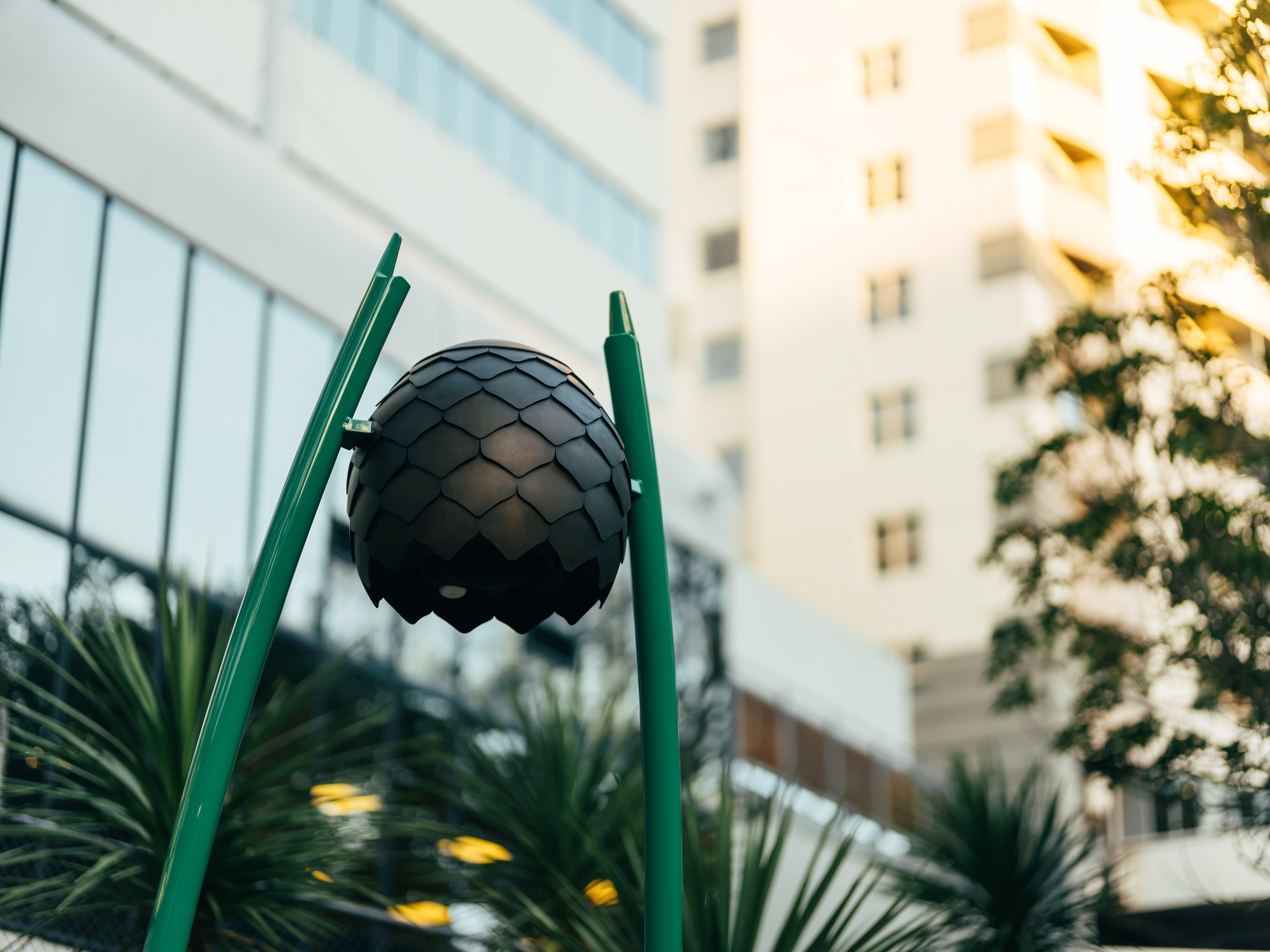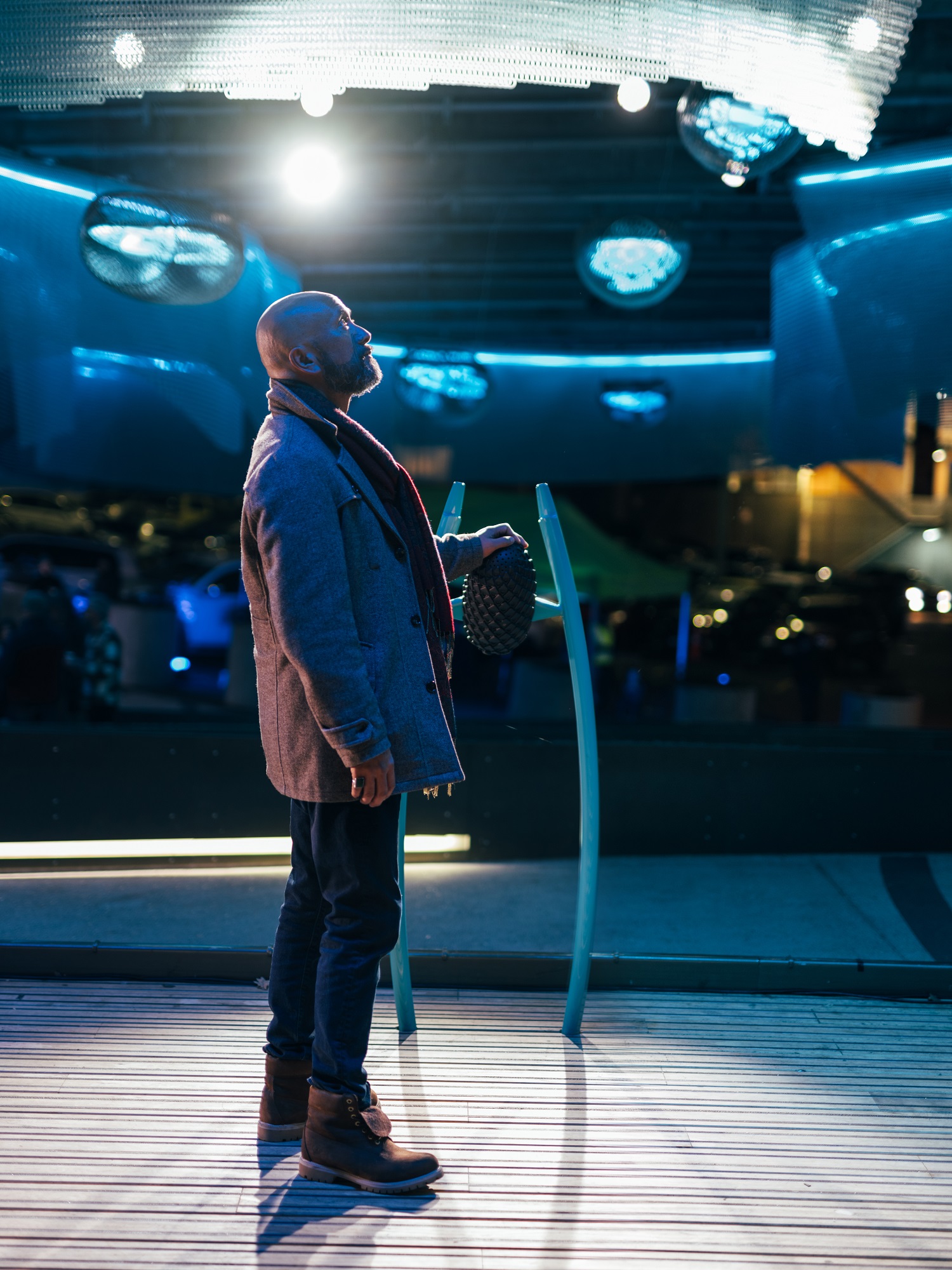Waimahara, an extraordinary interactive new Māori artwork in Myers Park, springs to life with mesmerising light and sound displays in response to special waiata.
If you sing a special waiata the artwork listens and responds, accompanying you with an awe-inspiring display of light and sound.
Commissioned by Auckland Council, this unique creation by artist Graham Tipene (Ngāti Whātua, Ngāti Kahu, Ngāti Hine, Ngāti Hāua, Ngāti Manu), technology experts IION, and skilled composers features two original waiata for the project.
Since its launch in December 2023, Waimahara has captivated visitors with a dynamic and immersive experience, where every movement and natural element influences its captivating displays. Explore more about this innovative installation here.

Kauri cone form; a wananga element of Waimahara.
Now there is a new way to interact with the artwork, described by Councillor Richard Hills as “epic.”
Councillor Hills explains that there are elements onsite to guide and support people wanting to learn and sing the waiata to trigger the full light and sound show.
“If you learn one of the waiata and sing it into the sculptural sensor positioned on the boardwalk, you’ll trigger an elaborate audio and light response to accompany you. Or if you prefer not to sing, you can still watch others perform or experience a more subtle, ambient display of light and sound with your presence in the underpass.
“This jewel of a park in the heart of the city centre has become multi-dimensional - an outdoor stage, a celebration of Māori in Tāmaki Makaurau, new tourism destination, gathering point, venue for future activations, and a place for education where the arts and technology combine in a beautiful collision,” says Councillor Hills.
Graham Tipene explains he wanted this artwork to support feelings of inclusiveness, belonging and welcome, by asking people to take part.
“With most artwork, you stand in front of it. But I wanted us to think differently with this one. I wanted the experience to surround you. I wanted this artwork to ask you to prepare your senses - to look, feel and listen,” Tipene explains.

Lead artist for Waimahara artwork Graham Tipene.
“It’s about whakarongo (awakening the senses) and trying to make an emotional connection. If you sing the right notes – the tune, the pitch – this artwork will ‘sing’ with you.”
The composers
The composers were Moeahi Kerehoma (Te Aitanga-a-Māhaki, Ngāti Whātua Ōrākei, Te Whakatōhea, Te Whānau-a-Apanui, Tūhoe, Ngāi Takoto, Te Rarawa), Tarumai-i-Tawhiti Kerehoma-Hoani (Te Aitanga-a-Māhaki, Ngāti Whātua Ōrākei, Te Whakatōhea, Te Whānau-ā-Apanui, Tūhoe, Ngāi Takoto, Te Rarawa) and Tuirina Wehi (Ngāti Ruapani). The audio producer for the project was Justyn Pilbrow (Ngāti Kahu).
The name Waimahara means a remembering of water, and a remembering of Te Waihorotiu, the stream that flows quietly underneath the underpass. Composer Tarumai-i-tawhiti Kerehoma-Hoani says the waiata speak about the importance of water in te ao Māori.

Pikiteora Mura-Hita, Enoka Wehi, Wairaka Mason, Tuwhiti Victor Happy, Taru mai-i-tawhiti Kerehoma-Hoani, Moeahi Kerehoma and Tuirina Wehi.
“In the lyrics we also talk about recognising and always acknowledging our environment – the wind, the rain – how the cycle of life continues and is everlasting.
“We pay respect to our ancestors who have held onto the knowledge that has been handed down to us. We’re fortunate to still retain that knowledge. It’s good to have an understanding of how we fit into this world. When we understand that in its entirety, we’re able to foster and be the guardians that we should be for the water, the land and the air that we breathe,” says Tarumai.
The big picture
Waitematā Local Board, Auckland Council, and the Auckland City Centre Advisory Panel have a keen interest in enhancing the visitor experience in Myers Park; making it a place all people and communities can enjoy and use in safety.
The project for the renewal of the northern end of the park – including boardwalk, wetland gardens, a new stairway from Queen Steet and a redeveloped underpass entry / exit – completes the redevelopment of Myers Park, supported by the city centre targeted rate.
Watch a video here and learn more about the climate resilience aspects of the Myers Park upgrade here.
Tessa Harris (Ngāi Tai ki Tāmaki) was also invited to develop a cultural artwork that would be embedded into the project. Tessa’s artwork can be seen in the patterning on the stairway that connects the Mayoral Drive and Queen Street corner with Myers Park.
Both artists - Graham Tipene and Tessa Harris - embraced the opportunity to develop a truly unique expression of te ao Māori in this place – adjacent to the Auckland Town Hall, Aotea Square, Queen Street, Q Theatre, Basement Theatre and the much-loved Civic Theatre – as part of a co-ordinated transformation of midtown.
Encompassing ten years of creative conceptualising, design, research, development and construction, through to completion in 2024, total investment in this artwork as part of the Myers Park upgrade project was $1.53M.
All photos were taken by David St George for Auckland Council.




